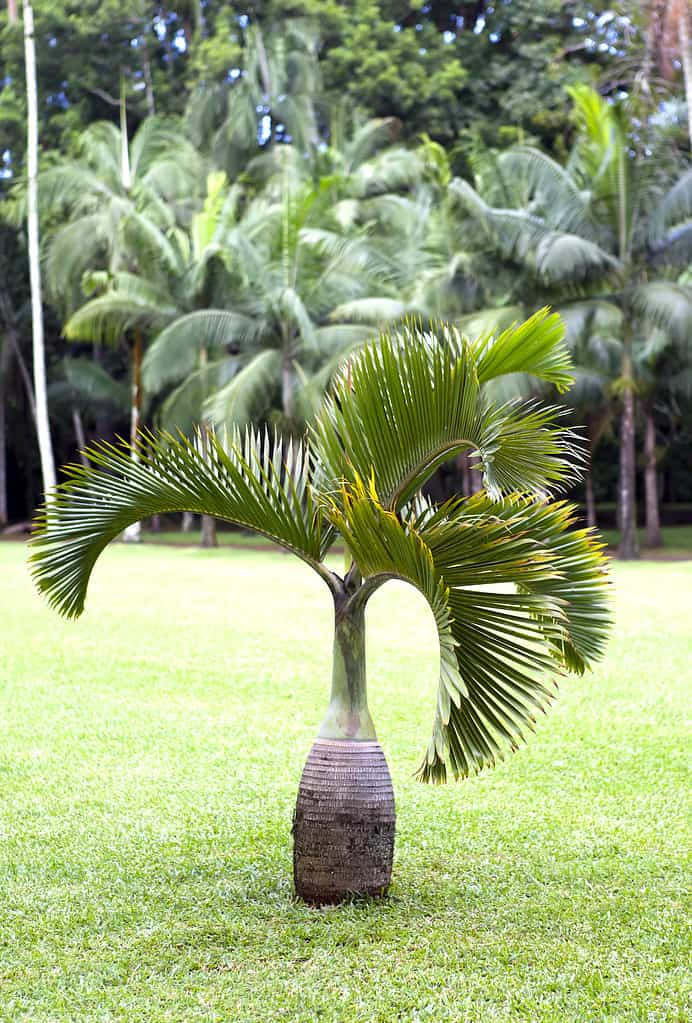Bottle palm trees are popular landscaping plants in the warm, coastal areas of the southern United States. Because of their unique, bottle-shaped trunks, they make for eye-catching specimen plants or focal points in larger landscape arrangements. Also, since they stay on the shorter side for many years, they have some versatility in terms of placement.
Caring for a bottle palm is straightforward. With a little bit of attention, you can even grow this plant indoors.

Bottle palm trees are popular in coastal settings and commonly used in landscaping.
©KKulikov/Shutterstock.com
| Botanical Name | Hyophorbe lagenicaulis |
| Common Name | Bottle Palm / Palmier bonbonne |
| Sunlight | Does best in full sun, but is tolerant of light shading. |
| Water | Regular watering is best to keep the soil moist but not wet. Relatively drought tolerant. |
| Soil | Adaptive but requires very well-draining soil with high organic matter content. pH closer to neutral is best. Tolerates salt spray. |
| Hardiness | Winter hardy in zones 10a–11. Does not tolerate freezing temperatures for long periods. |
| Indoor or Outdoor? | Does well both indoors and outdoors. |
| Beginner Friendly? | Yes. |
| Conservation Status | Critically endangered |
What Is a Bottle Palm?
The bottle palm is considered a true palm tree. It is native to Round Island, which is a small island east of Madagascar. Like all other true palms, it belongs to the family Aracaceae.
Some palms, like the rattan palm, climb like vines. Others grow to towering heights like the coconut palm. The bottle palm, however, stays short and squat for many years of its life and produces an unusually bottle-shaped trunk.
At maturity, these trees can grow to around 15 feet in height. However, this can take many decades. They are slow-growing and will most commonly reach about 8–10 feet in height after several years of cultivation. The crown of the bottle palm is relatively short and produces between 4 and 8 long, pinnate (feather-shaped), compound leaves called fronds. Each frond is V-shaped and made up of 140 narrow leaflets.
In the early to mid-summer, bottle palms produce many small, white flowers. They are borne in dense clusters on long stalks that emerge from the meeting point of the trunk and crown shaft of the tree. Each tree is monoecious, meaning that it has both male and female flowers, and produces green to black fruits after flowering. The fruits contain a single seed that can be planted to produce a new bottle palm within 6 months.
Due to habitat loss, the bottle palm and all of its Hyophorbe relatives are considered critically endangered. Although there are many specimens in cultivation worldwide, there are only 10 wild bottle palms left in their native range.
How to Care for a Bottle Palm
Whether you’re growing your bottle palm indoors or out, care requirements are largely the same. As long as you can supply your plant with conditions that closely mimic those of its native habitat, you should have few problems. Use the following guidelines to make sure that your bottle palm has everything it needs to thrive.
Sunlight
In its native island habitat, the bottle palm grows in direct sun. Although trees of this species will become relatively tall at maturity, this will take many years. Ensure that surrounding landscape plants do not shade them out too heavily. While not ideal, they can grow fairly well in partial shade.
If you are growing your plant indoors, make sure that it is in an area of your home that receives bright light for at least 6–8 hours per day. If this is not possible, you may be able to move smaller trees outside for part of the day to help them get the light they need. The bottle palm is often planted in containers and used to decorate the edges of porches and pool cages. This can be a good compromise if in-ground landscaping space is limited, and plants can be brought indoors if desired.
Water
This palm tree requires a decent amount of water to stay healthy. While it is relatively tolerant of drought, it should be watered consistently during hot, dry weather to keep it from drying out. Take care to avoid over-watering, however. The bottle palm, like many plants, requires good oxygenation of its roots and may drown in standing water.
Soil Conditions
Because its roots require constant oxygenation, the bottle palm requires well-draining soil. It is not overly picky about what this soil is comprised of, however. As long as the water does not pool up around its roots, the bottle palm can adapt to a range of soil compositions. Soil that contains some amount of clay and silt is ideal, however, as it contains more calcium, potassium, and magnesium than sand. Sandy soils will work as well but may need more frequent fertilization to prevent nutrient deficiencies.
If you are growing your bottle palm in a container, much standard potting soil mixes work well as long as they are well-draining. Sand-heavy mixes are ideal. Be aware that the limited soil volume of a container means that you will need to water your palm more frequently. Remember that you should always mulch your plant’s soil to slow evaporation.
Fertilization
If your landscape is particularly sandy or rocky, you should fertilize two to three times per year with a fertilizer formulated specifically for palm trees. These slow-release types of fertilizer tend to be heavy in potassium and will usually supply all the micro-nutrients that your palm needs to thrive.
Even the best potting soils eventually become spent. Containerized palms will need fertilization as they consume the nutrients in their limited soil. The same types of slow-release fertilizers can be used for containerized and indoor palms as for outdoor palms.
To help ensure that your palm will face fewer nutrient problems in the future, you can mix some well-developed compost into your plant’s soil as you put it into its hole. This not only supplies your plants with crucial macronutrients but also increases the pore size of the soil. Once your bottle palm is in the ground, you can apply seasonal top dressings of compost to help meet its nutritional needs.
Common Deficiencies
Potassium deficiency is very common in cultivated palm trees, especially in the sandy soils of the coastal south. Potassium (K) is a macronutrient that is critical to plant health and metabolism. Without enough of it, your palm may struggle to uptake water and produce the sugars it needs to survive. Symptoms of potassium deficiency may include yellow spotting that appears first on older leaves, as well as necrosis of the tips and edges of leaves. These symptoms may appear singly or at the same time.
Deficiencies in manganese (Mn) are also common and often appear hand-in-hand with a potassium deficiency. The symptoms are similar, but manganese deficiencies tend to present streaking necrosis rather than necrosis at just the tips or leaf edges. Manganese-related necrosis also tends to affect new leaves rather than old ones. New leaves will appear yellow and may exhibit stunted growth. In advanced cases, new leaves may emerge with a distorted and disfigured appearance.
Common Pests and Diseases
Like any plant, your bottle palm may become host to insect pests. Palm aphids are the only known aphid species to infest palm trees. These aphids are wingless, nearly flat, and oval-shaped. Their carapace is dark brown with a waxy white outline. Like other aphids and scale bugs, they feed on the sap from their host plant’s leaves.
While bottle palms are not particularly disease-prone, infection is still possible. Several diseases can occur in all palm species. One such disease, Ganoderma butt rot, is caused by a fungus that is related to the reishi mushroom. When Ganoderma zonatum infects a palm tree, it invades the tissue of the lower trunk and begins to digest the lignin inside the plant. It can cause The only way to diagnose this disease is to look out for a bracket-shaped conk that emerges from the lower portion of the tree. Unfortunately, there is no cure for this disease.
The disease is often a secondary problem that occurs when a plant is struggling. The best thing you can do to prevent disease is to care for your plant consistently and properly.
Thank you for reading! Have some feedback for us? Contact the AZ Animals editorial team.








